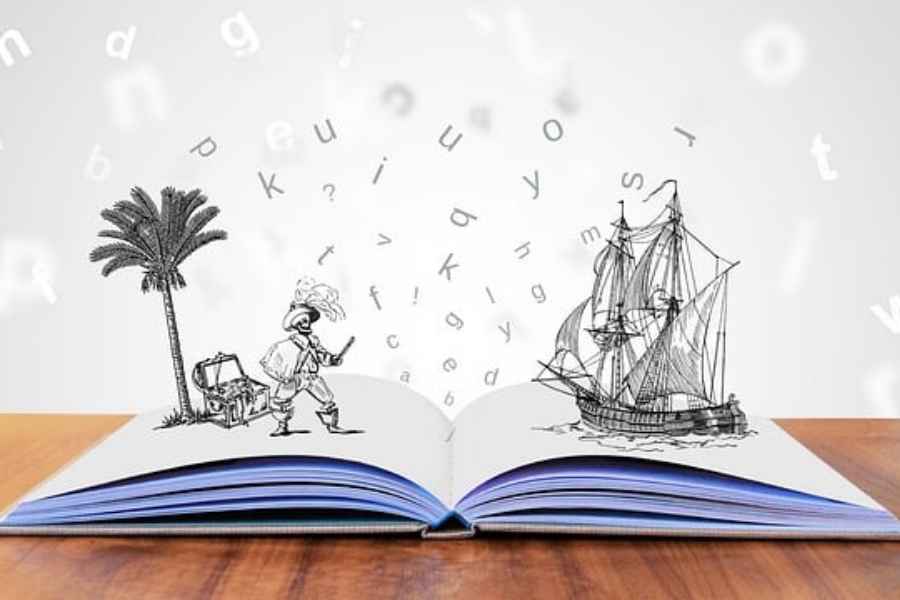So you’re keen on crafting a compelling tale, but you’re not sure where to start?
Understanding the basic elements of a story is your golden ticket.
Whether you’re an aspiring novelist, a marketer weaving brand narratives, or a short story wizard, this guide’s got you covered.
We’ll break down the 5 essential literary elements that’ll enhance your narrative, complete with actionable tips and real-world examples.
Ready to turn that shaky draft into a masterpiece?
Let’s dive right in.

1. Story Framework
Before you jump into the messy, delightful chaos of storytelling, it’s crucial to lay down some groundwork.
Think of the story framework as the blueprint for your literary skyscraper.
Without it, you risk constructing a story that’s more like a house of cards, teetering and ultimately collapsing under its own weight.
Plot
Often misconstrued as mere events, the plot is a lot more than a series of happenings. It’s the driving force, the skeletal framework, that gives your compelling story its shape and momentum.
Crafting a remarkable plot structure is akin to placing dominoes in a compelling pattern; you’re setting up a series of events so intrinsically connected that when one domino falls, it sets off a chain reaction leading to an inevitable yet unexpected climax.
Let’s consider George Orwell’s “1984.” The story structure doesn’t just mechanically move from point A to B; it reels you in with a politically charged atmosphere and mounting tension.
By the time you reach the gut-wrenching climax, you’re invested not just in the outcome but in the underlying implications.
You’re not simply wondering what will happen to Winston; you’re pondering the consequences of unchecked government power.
Pacing

Pacing is your story’s heartbeat. It’s not uniform; it quickens in moments of excitement and slows down for introspection or elaboration.
The balance is delicate.
A thriller, for instance, can’t be a roller-coaster ride from start to finish; it needs moments of quiet where the reader can catch their breath.
Conversely, a romantic drama that gets lost in endless contemplation and dialogue risks losing reader engagement.
J.R.R. Tolkien masterfully handles pacing in “The Lord of the Rings.”
Between the nerve-wracking encounters with orcs and the palpable tension of the ring’s influence, there are moments of rest and beauty in places like Rivendell.
These respites not only give the characters a break but allow the readers to fully absorb the gravity of the quest ahead.
Resolution
The resolution is where all your intricately placed dominos finally tumble, where the knots you’ve tied throughout the narrative are deftly unraveled.
It’s the standing ovation at the end of your performance, and it needs to satisfy.
Whether you leave your audience cheering or deep in thought, the resolution should feel both surprising and inevitable. It’s a paradox, but hitting this sweet spot makes your story unforgettable.
2. Key Character Elements

No matter how intricate your plot, your story risks flatlining without compelling characters.
They’re the blood and muscle that wrap around your story’s skeletal plot, giving it life and energy.
But what constitutes a memorable character?
Character Dynamics
Characters aren’t just placeholders or tools to move your plot along; they’re the individuals your readers will cheer for, cry over, and perhaps even dream about.
To create an impactful main character, dig deep into their psyche and unveil their complexities. Character traits like quirks, hidden fears, or irreverent humor make a main character relatable and real.
Sherlock Holmes, for instance, is not merely a detective; he’s a keen observer with an almost superhuman analytical mind.
But he also battles drug addiction and emotional isolation.
These layers make him more than a dynamic character; they elevate him to an individual.
Dialogue
Dialogues do more than just offer exposition or move the plot along; they’re a window into the characters’ souls.
Each utterance, each pause, each hesitation or fervor in their speech enriches the fabric of their personality.
Imagine “Gone With the Wind” without Scarlett O’Hara’s defiant “As God is my witness, I’ll never be hungry again!”
Her words encapsulate her resilience and give readers an unfiltered look into her indomitable spirit.
Conflict
Let’s not forget about conflict. Characters, like real people, are shaped by challenges and dilemmas.
No one wants to read about a protagonist who breezes through life untouched and unchanged. They want a dash of internal or external conflict.
Conflicts serve as the crucible in which character metal is tested and transformed.
When JK Rowling’s Harry Potter faces the moral ambiguities of war and leadership, we see him evolve from a naive boy into a wise young man, shaped by the battles he fought — both within himself and against dark forces.
3. World Building

World building is like painting on a blank canvas. Only the canvas stretches beyond your immediate view.
It encompasses everything — mountains and rivers, cities and hamlets, laws of physics, and social norms.
This is the backdrop against which your plot unfolds, and your characters evolve.
Setting
When we talk about setting, we’re not just referencing the location or the timeline. A well-defined setting is a living, breathing entity.
In stories like Cormac McCarthy’s “The Road,” the post-apocalyptic landscape is so palpable it practically becomes a character itself, influencing actions and decisions, and challenging the characters in unique ways.
Remember, a Civil War drama wouldn’t carry the same gravity if it were set in a suburban shopping mall.
Mood
Mood isn’t just about adjectives and the weather. It’s an emotional climate that envelopes your reader.
You can have an idyllic setting with a sinister mood, adding layers of complexity to your story.
Writers like Edgar Allan Poe are masters at creating a thick, almost tangible atmosphere of dread, which serves as a critical element of the story.
Crafting mood involves an array of literary devices — think of the choppy sentences in a suspenseful scene or the flowy prose in a romantic moment.
The atmosphere you create can amplify your characters’ emotions and significantly elevate your story.
Context
Whether you lay it out explicitly or let it hover subtly in the background, context enriches your narrative. It can be historical facts, social structures, or even the prevailing economic conditions.
While not always explicitly stated, context shapes the boundaries of your world.
In “Pride and Prejudice,” the context of English Regency-era social norms is so integral it influences every action and dialogue in the story, adding depth and resonance.
4. Thematic Depth

Thematic depth weaves together the raw elements of your story into a narrative bursting with nuance and meaning. This is where your story gains its unique fingerprint.
Sure, hundreds of stories might revolve around love, friendship, or vengeance, but it’s your take on these themes that sets your tale apart.
Theme
When we talk about the theme, we’re digging into the philosophical underbelly of your narrative.
You see, your characters may dance, and your plot may dazzle, but what are you really trying to say?
Are you discussing the human condition through the lens of a post-apocalyptic world, like Cormac McCarthy in “The Road”?
Or perhaps you’re unpacking the complexities of the American Dream like F. Scott Fitzgerald in “The Great Gatsby.”
Understanding your theme will not only guide your writing but also deepen the connection with your readers. It’s the takeaway message that leaves an imprint long after the book is closed.
Motif
Motifs keep your theme from becoming just an abstract concept; they root it in the very fabric of your narrative.
Imagine reading George Orwell’s “1984” and not stumbling upon the omnipresent surveillance. It serves as a motif that continually reinforces the theme of totalitarianism.
Symbolism
And let’s not forget symbolism. It acts as a shorthand, allowing your reader to delve deeper into the story without getting bogged down by extensive explanations.
In “Life of Pi,” Yann Martel uses the ocean as a symbol of life’s unpredictability and vastness.
Just a mention of the ocean, and the reader instantly taps into a whole web of associated ideas and feelings.
5. Narrative Voice

The narrative voice is the unseen conductor of your story’s orchestra, guiding your readers through the valleys and peaks of your narrative landscape.
Think of it as the inviting aroma that lures people to the kitchen — it sets expectations and either entices or repels your audience.
Point of View
Your choice in point of view can be as defining as a character in your story.
Opt for a first-person perspective, and you’re inviting the reader into the intimate thoughts of your protagonist, akin to Holden Caulfield in “The Catcher in the Rye.”
Switch to a third-person omniscient, and suddenly you’re like J.R.R. Tolkien in “The Lord of the Rings,” able to explore the inner workings of multiple characters and even the history of Middle Earth itself.
Your choice impacts not only how the story unfolds but also how your readers emotionally connect with it.
Narrative Style
A narrative style can add layers of complexity or simplicity to your story, thus altering its impact.
Consider the epistolary form used in “Dracula” by Bram Stoker.
Through letters, diary entries, and newspaper clippings, the story reveals itself in fragmented bursts, each piece adding to the sense of dread and intrigue.
Another interesting approach is the stream-of-consciousness technique as seen in James Joyce’s “Ulysses.”
The style adds a raw, untamed quality that perfectly complements the wandering thoughts of its characters.
Tone
Your tone is the color palette with which you paint your narrative landscape.
You might opt for a cheerful and optimistic tone, filling your story with sunlight and rainbows, much like “Anne of Green Gables.”
Alternatively, if you’re aiming to add a touch of darkness, you could follow the footsteps of Stephen King, whose tone often highlights the lurking dangers in ordinary life.
It adds an extra layer of richness, helping your story to encapsulate a multitude of human emotions.
Ready to Master the Elements of a Story

We’ve all felt it — the emotional tug of a compelling story so powerful it lingers in our thoughts, days after the final page.
Armed with each story element, you’re poised to create stories that resonate deeply.
So, go forth, use these literary elements, and enchant your readers with a great story.



